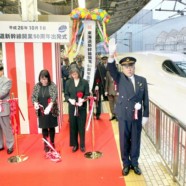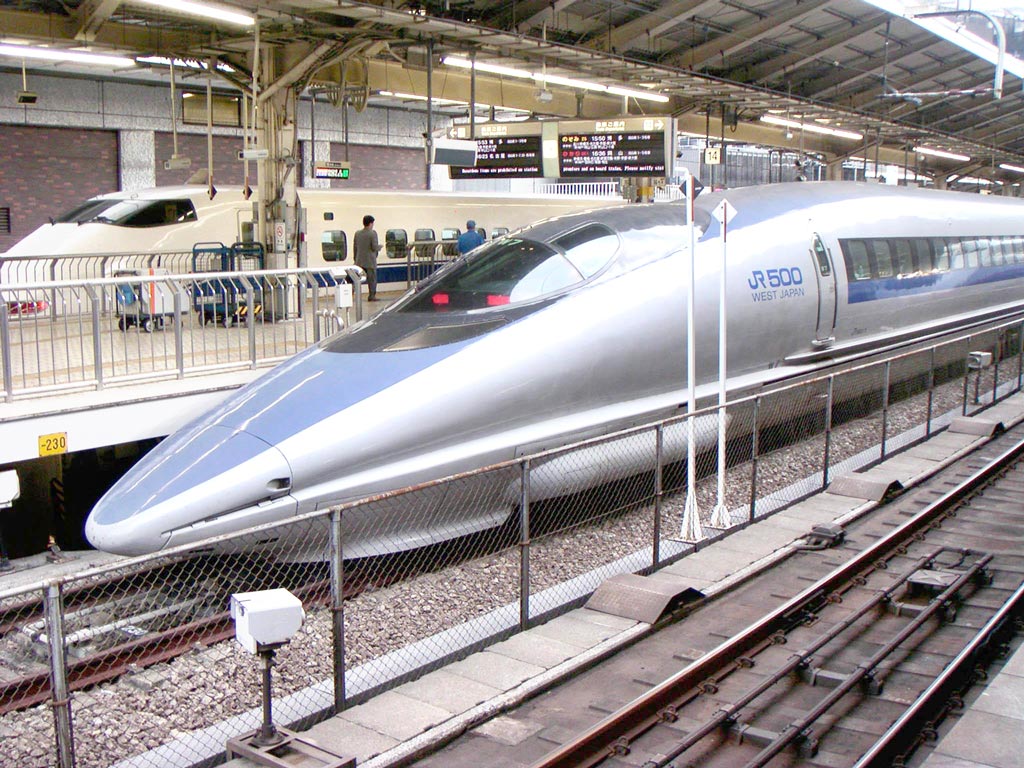50 years Shinkansen
50 Tahun Beroperasi Shinkansen Jepang Tak Pernah Kecelakaan.
Peringatan 50 tahun kereta peluru Jepang (Shinkansen) dilakukan Rabu (1/10/2014) pukul 05.30 pagi dengan pemotongan pita para pejabat transportasi Jepang dan peluncuran Shinkansen pertama.
Peluncuran pertama kali Shinkansen di Jepang tanggal 1 Oktober 1964 untuk menyesuaikan diri dengan Olimpiade Tokyo. Saat itu bernama Tokaido Shinkansen dan hari ini dirayakan ulang tahunnya yang ke-50. Shinkansen ini dielukan masyarakat Jepang sebagai ‘Realisasi Mimpi’ yang berkecepatan 210 kilometer per jam. Dengan Shinkansen jarak Tokyo-hin Osaka yang tadinya lebih dari 4 jam, kini hanya ditempuh dengan waktu sekitar 2 jam 25 menit saja.
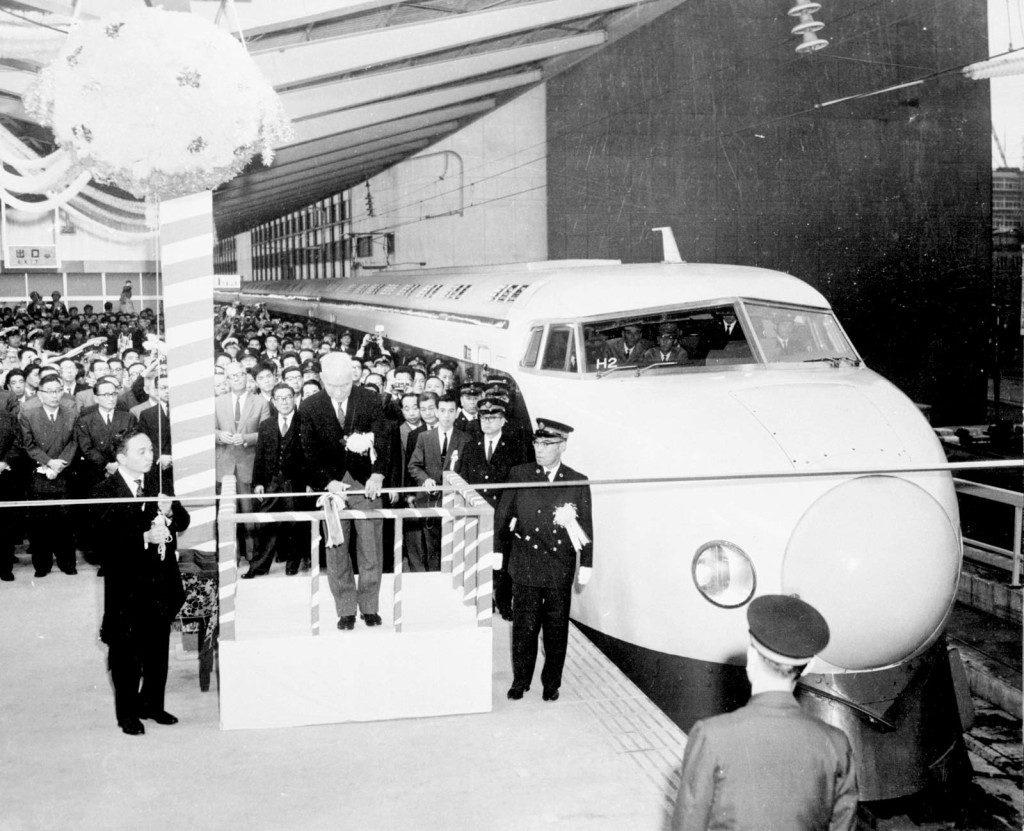
On Oct. 1, 1964, Japanese officials in Tokyo cut the ceremonial tape to dedicate the world’s first high-speed passenger railroad, the Tokaido Shinkansen “bullet train,” which covered the 515 km (320 mi) between Tokyo and Osaka in just three hours. Credit: Kyodo/Landov
Selama 50 tahun terakhir ini belum pernah sekali pun terjadi kecelakaan Shinkansen di Jepang yang mengakibatkan kematian penumpang. Kecelakaan kereta pindah jalur terjadi hanya 2 kali. Kecelakan pindah jalur terjadi karena gempa bumi di tahun 2004. Dan satu lagi pindah jalur karena musim dingin yang sangat kuat mengakibatkan badai salju di tahun 2013. Alat deteksi gempa mengaktifkan alat anti pindah jalur, sehingga walaupun pindah jalur terjadi, tidak akan mengakibatkan kecelakaan yang berarti. Jumlah penumpang Shinkansen selama 50 tahun ini berjumlah sedikitnya 10 billion penumpang.
Shinkansen dioperasikan oleh Jepang National Railways (JNR) dengan konstruksi terutama Tohoku Shinkansen dan Sanyo Shinkansen oleh Japan Railway Construction Perusahaan Umum yang bertanggung jawab pula atas konstruksi Joetsu Shinkansen. Belakangan Tohoku Shinkansen dan Joetsu Tokyo berpisah setelah terjadi privatisasi.
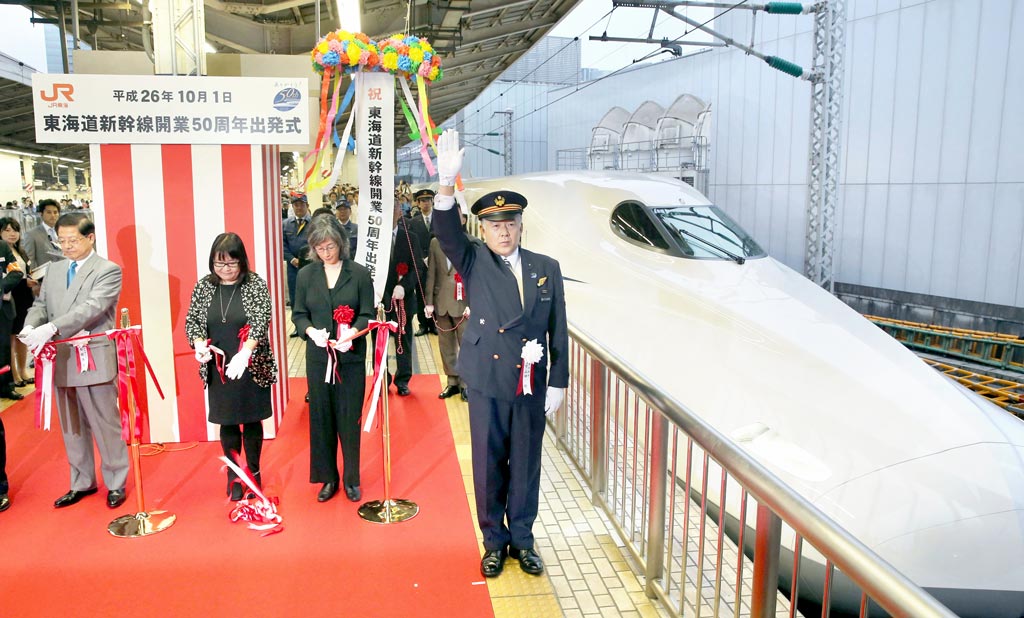
A ceremony is held to mark the 50th anniversary of the launch of Japan’s bullet train between Tokyo and Osaka, at Tokyo Station in Tokyo Wednesday, Oct. 1, 2014. Zipping cross-country in a super-high speed train has become commonplace in many countries these days, but it was unheard of when Japan launched its bullet train between Tokyo and Osaka 50 years ago Wednesday. (credit Kyodo News / AP)
Shinkansen baru seperti Kyushu Shinkansen dan Hokuriku Shinkansen dibangun setelahnya. Konstruksi kereta api dan mekanisme bantuan pembangunan sarana transportasi dimiliki hak-haknya oleh Shinkansen Holding Corporation dan Japan Railway Construction, Perusahaan Umum yang telah menjadi sebuah entitas konstruksi. Di sisi lain, JR Tokai telah dinominasikan dalam pembangunan terutama untuk Chuo Shinkansen yang merupakan jalur Shinkansen yang baru.
Perlu dicatat, didefinisikan dalam Pasal 4 UU Transportasi Jepang, pembangunan kereta api Shinkansen diatur oleh Kementerian Pertanahan, Infrastruktur dan Transportasi. Rencana pembangunan Shinkansen ditentukan oleh negara.
Sumber: tribunNews
=======================================
Japan’s Shinkansen Bullet Train Turns 50.
It was, retired Japanese railway engineer Fumihiro Araki recalls, “like flying in the sky.”
Zipping cross-country in a super-high speed train has become commonplace in many countries these days, but it was unheard of when Japan launched its bullet train between Tokyo and Osaka 50 years ago Wednesday.
The Shinkansen, as it’s called in Japan, gave a boost to train travel in Europe and Asia at a time when the rise of the automobile and the airplane threated to eclipse it. It also was a symbol of pride for Japan, less than two decades after the end of World War II, and a precursor of the economic “miracle” to come.
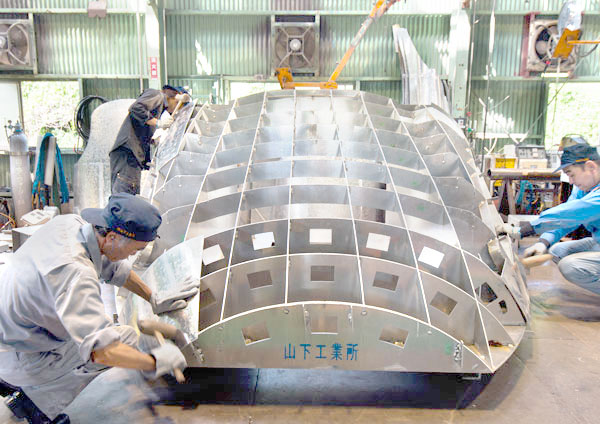
Traditional Craft : Japan’s first bullet train, the Tokaido Shinkansen, which ran from Tokyo to Osaka, opened on October 1, 1964, nine days before the Tokyo Olympics. This aerodynamic, futuristic train ran at a speed of 210 km/h, and foretold the rapid advancement of Japan. Today, half a century later, Japan’s society has changed, but the Shinkansen continues to be an existence that symbolizes Japan’s technology and advancement. Picture above taken at Yamashita Kogyosho Co., Ltd. in Kudamatsu City, Yamaguchi Prefecture, that has been making the train’s front-end nose structure called odeko (forehead) since the first 0 series Shinkansen. Here, numerous artisans still, manually, by hand, pound metal sheets just as they did in the early days. (credit: courtesy photo axisjiku)
The Oct. 1, 1964, inauguration ceremony was re-enacted at Tokyo Station on Wednesday at 6 a.m., complete with ribbon cutting. The first bullet train, with its almost cute bulbous round nose, traveled from Tokyo to Osaka in four hours, shaving two and a half hours off the 513-kilometer (319-mile) journey. The latest model, with a space-age-like elongated nose, takes just two hours and 25 minutes.
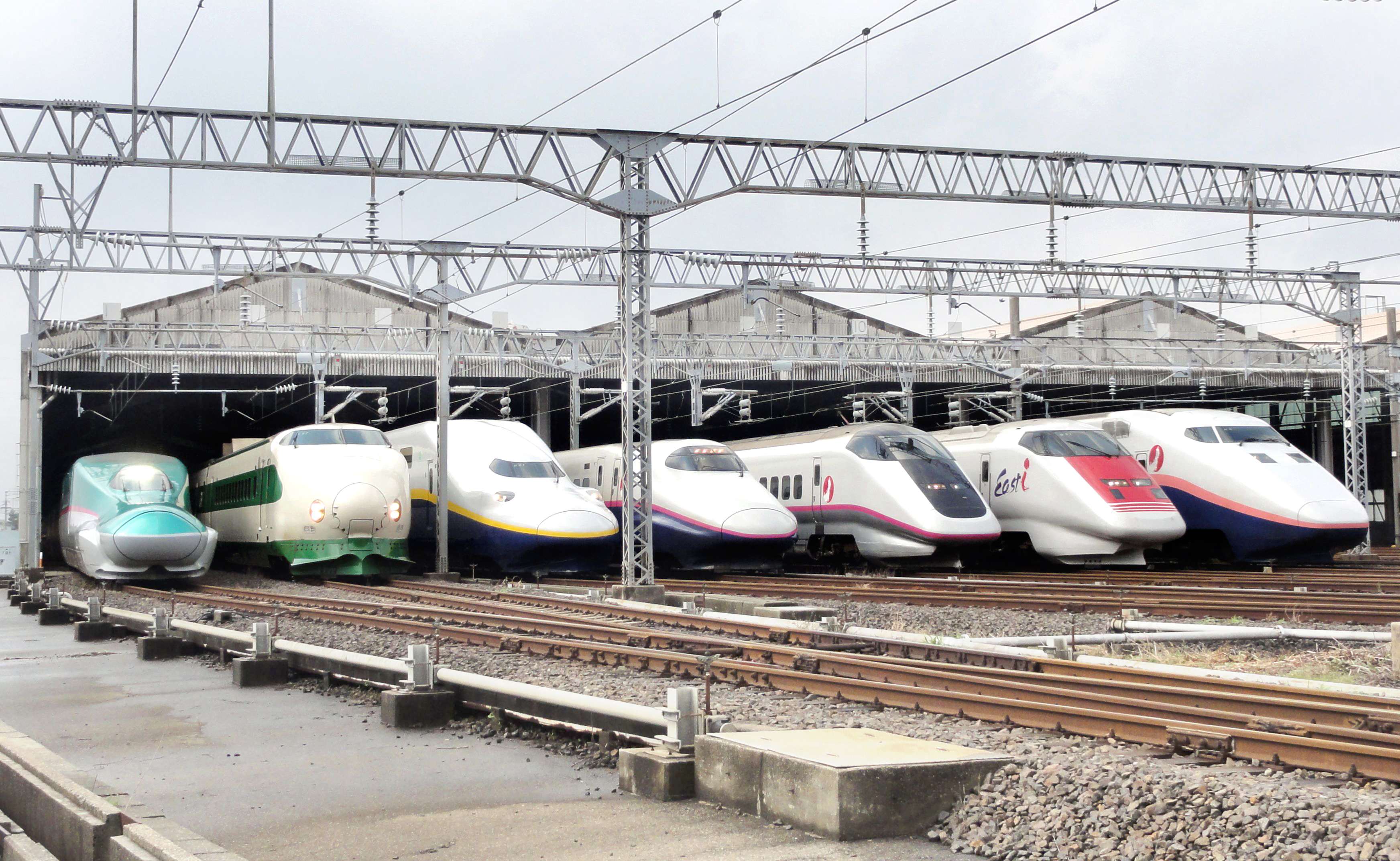
JR East Shinkansen lineup at Niigata Depot on a Public opening Event (the 30th Anniversary of the Jōetsu Shinkansen) at Niigata Shinkansen Rolling Stock Center / (from the Left) E5 Series, 200 Series, E4 Series, E2 Series, E3 Series, E926 Type (East i), and E1 Series. (credit: wikipedia)
Araki, now 73, drove the Shinkansen briefly in the summer of 1967 as part of his training as a railway operations engineer. Last week, he slipped back in time as he sat in the driver’s seat of one of the early model bullet trains at a railway museum outside of Tokyo. He pulled a lever on the control panel, looking straight ahead as he was trained, though all he could see were other museum exhibits.
“It was like flying in the sky, it was that kind of feeling,” said Araki, the acting director of the museum. “On a clear day, you could see Mount Fuji, and riding atop the railway bridge at Hamanako lake was very pleasant. It felt like you were sailing above the sea.”

In this Sept. 24, 2014 photo, a Shinkansen bullet train heads for Tokyo Station near Shimbashi Station on the Tokaido Main Line in Tokyo. Japan launched its bullet train between Tokyo and Osaka 50 years ago Wednesday, Oct. 1, 2014. (credit: Shizuo Kambayashi / AP)
A CONTROVERSIAL PROJECT
Japan started building a high-speed line during World War II, but construction was halted in 1943 as funds ran out. The idea was revived in the 1950s, but many questioned undertaking such a costly project, particularly with the expansion of air travel and highways. Criticism turned to pride when construction, financed partly by an $80 million World Bank loan, was completed in time for the Tokyo Olympics in October 1964.
HOW FAST?
The first Shinkansen had a maximum speed of 210 kilometers (130 miles) per hour. The fastest trains previously, in Europe, could reach 160 kph. Today’s bullet trains, in Japan and elsewhere, have reached and in some cases exceeded 300 kph (186 mph). By average speed, China has the fastest train in the world, averaging 284 kph on a route between Shijiazhuang and Zhengshou Dong, according to a biennial World Speed Survey by Railway Gazette.
EUROPE, ASIA, BUT NOT THE U.S.
The Shinkansen renewed interest in high-speed rail elsewhere, notably in Europe. France and Spain are among the leaders in Europe, and Turkey last year became the ninth country to operate a train at an average speed of 200 kph, according to Railway Gazette. South Korea and Taiwan also operate high-speed systems in Asia. The United States is an exception, though there are proposals to build lines in California and Texas. The fastest train in the U.S., Amtrak’s Acela Express, averages 169 kph (105 mph) on a short stretch between Baltimore and Wilmington, Delaware, the speed survey says.
WHAT’S NEXT
Magnetic levitation. Shanghai launched a German-built maglev train in 2004 on a 30-kilometer route between the city and the airport. It can hit 430 kph (267 mph). A Japanese maglev train in development has topped 500 kph (310 mph) in tests. If built, it could reduce the travel time between Tokyo and Osaka to just over one hour. With speed, though, some of the romance is lost. A faster Shinkansen has eliminated its dining car. “The problem is that Japan is such a small country,” said Araki, the retired engineer. “If you go too fast, you’ll get there in no time. No time to enjoy an onboard meal.”
Source: Noriko Kitano / Associated Press
========================================

